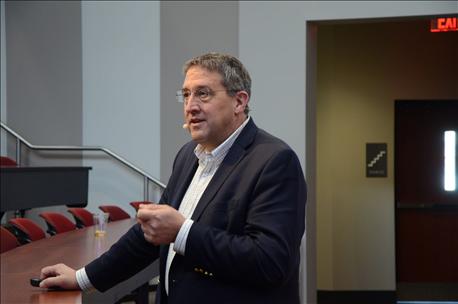
Up until the digital age, agriculture had undergone three revolutions. The first was mechanization, going from human and animal power to internal combustion engines. The second was the Green Revolution, which marked the widespread adoption of commercial fertilizer and hybrid seed, followed by the third, which involved genetically modified organisms.
At the 2016 Nebraska Agriculture Technology Association Conference in February, Scott Shearer, professor and chair of the Ohio State University's Department of Food, Agriculture and Biological Engineering, said agriculture is currently experiencing the fourth revolution – the Internet of Things.

AGRICULTURE 4.0: At the 2016 Nebraska Agriculture Technology Association Conference in February, Scott Shearer, professor and chair of the Ohio State University's Department of Food, Agriculture and Biological Engineering, said agriculture is currently experiencing the fourth revolution – the Internet of Things.
But just what does this next wave of progress – what Shearer refers to as Agriculture 4.0 – entail? It's no secret that just about every device, from smartphone to tablet to tractor is Internet-connected. This means users, including farmers, are hyper-connected.
"We figure in North America, farmers are generating about half a kilobyte of data per corn plant. The average email message is about two kilobytes. Every acre of corn is sending you about 9,000 email messages during the growing season," Shearer says. But that's nothing compared to the amount of data generated when remote sensing is thrown into the mix – about five kilobytes per plant. "We're literally talking about petabytes being generated in North America."
Sure, farmers are generating a ton of data. The question is: how is this going to pay off? Using this data is all about managing the crop while it's growing.
"Historically we've made our cropping plans, we've gone out and executed them, we've looked at the yields at the end of the year, and we've decided next year what we're going to do differently," Shearer told the audience at the 2016 Nebraska Agricultural Technology Association Conference in February. "Because of a lot of things that are happening today, we're going to close that loop during the growing season. We're going to change our management to accommodate what's going on with weather, as well as how the crop is responding to various inputs."
~~~PAGE_BREAK_HERE~~~
Shearer's outlook for the next agricultural revolution includes a prescription for every input managed – and that means working with different companies so the farmer has the freedom to change between suppliers of inputs on a year-to-year basis. This includes prescriptions for nitrogen rates, seeding rates, irrigation scheduling, and with new planter technology, the right hybrid for the acre. Telematics and remote-sensed imagery, when used right, can also be used to tell a story of how good of a job the operator did.
But remote sensing doesn't just apply to looking at the entire field to pick out patterns of variability. Shearer notes using high-resolution remote sensed imagery, researchers can do stand counts and monitor plants at the individual level. For example, a recent Oklahoma State University study involved adjusting the axis of the seed in-furrow, placing the seed normal to the row to control the leaf canopy architecture – resulting in a 10% to 15% increase in yield. Meanwhile, using high-resolution imagery and hyperspectral cameras, researchers are able to create a 3D model of a plant in the field through use of in-field phenotyping.
But Big Data and remote-sensed imagery also might be used to enroll in USDA programs, crop insurance, or for stewardship compliance – I've even heard some people say to market grain, you'll have to demonstrate how much nitrogen was used, how much soil erosion occurred, and how much water was used. "I think some things are going to come together," Shearer says. "They're going to make these technologies not only cost-effective, but they could be the solutions to some of these concerns people have about the environment."
About the Author(s)
You May Also Like






